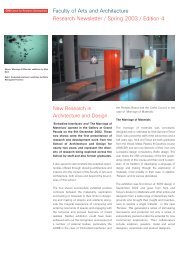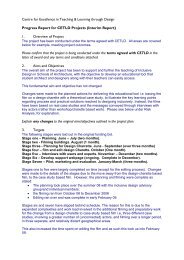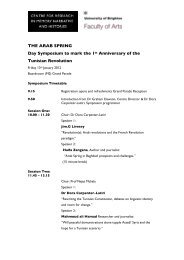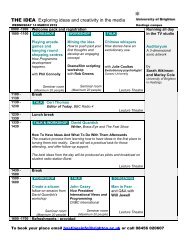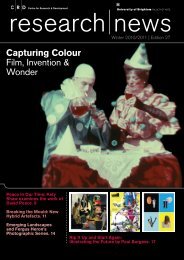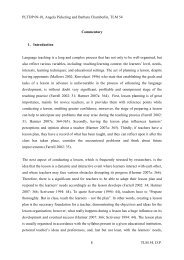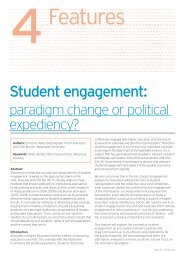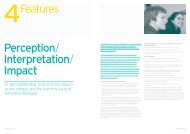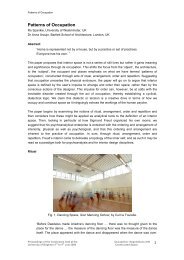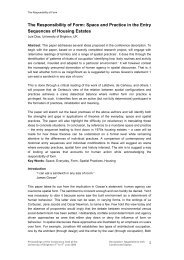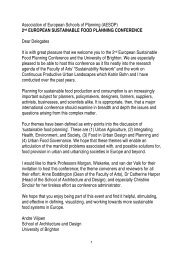Introduction to Made 2011 by Joanna Lowry
Introduction to Made 2011 by Joanna Lowry
Introduction to Made 2011 by Joanna Lowry
Create successful ePaper yourself
Turn your PDF publications into a flip-book with our unique Google optimized e-Paper software.
made<br />
It is common for people <strong>to</strong> talk about ‘taking’ pho<strong>to</strong>graphs, as though perhaps the<br />
pho<strong>to</strong>graphs are already there, immanent in the material world, simply awaiting<br />
extraction <strong>by</strong> the pho<strong>to</strong>grapher. Or perhaps the sense is that they are even s<strong>to</strong>len<br />
from the world <strong>by</strong> a pho<strong>to</strong>grapher who bears more resemblance <strong>to</strong> a thief than an<br />
artist. Pho<strong>to</strong>graphs from this perspective are hunted or collected, then added <strong>to</strong> the<br />
archive of all those images taken, and all those waiting <strong>to</strong> come. ‘To Take’ implies a<br />
swift, grasping gesture, and sometimes this act is attributed, tellingly, <strong>to</strong> the<br />
apparatus itself – it is the camera that ‘takes’ the picture. In one click of the shutter a<br />
small fragment of reality is trapped on film inside the dark body of the apparatus<br />
itself. An au<strong>to</strong>matism without any real human agency. The image taken from the<br />
world.<br />
What might it mean, alternatively, <strong>to</strong> think about ‘making’ pho<strong>to</strong>graphs, <strong>to</strong> consider<br />
the pho<strong>to</strong>grapher less as a hunter or collec<strong>to</strong>r, and more as an artist or craftsman?<br />
How would this be different, and what might it imply for the way we think about the<br />
medium? One thing it alerts us <strong>to</strong> is the problem of what we include in that act of<br />
making – it moves our attention away from the act of pressing a but<strong>to</strong>n, the authored<br />
act of selection, and directs us <strong>to</strong>wards all those expanded activities that surround<br />
that moment: the exploration of a world and the slow process of development of an<br />
understanding of the truth you want <strong>to</strong> convey; the decision making about how and<br />
when <strong>to</strong> take the pho<strong>to</strong>graph; perhaps the construction of materials and sets and the<br />
assembling of props and models and ac<strong>to</strong>rs; the development of a closer<br />
acquaintance with the apparatus, the camera, the film, the lighting equipment; the<br />
processing, development, printing, the post-production, colour balancing,<br />
re<strong>to</strong>uching; the decisions about paper, framing, or installation.<br />
There is a complexity <strong>to</strong> this slow and elaborate process of the manufacturing of a
pho<strong>to</strong>graph that is often forgotten in our obsession with the image and our<br />
proccupation with the currency of the virtual. This is a complexity that is located in the<br />
very materiality of the pho<strong>to</strong>graphic process and it underpins the difficulty of making<br />
as an activity. In the nineteen eighties and nineties serious pho<strong>to</strong>graphic practice was<br />
transformed <strong>by</strong> two debates: the first coming out of discussions about<br />
postmodernism and the culture of the simulacrum, and the second emerging out of<br />
the influence of conceptual art and the irreverent use made <strong>by</strong> artists of pho<strong>to</strong>graphy<br />
<strong>to</strong> record and document, <strong>to</strong> archive performances and <strong>to</strong> represent abstract ideas.<br />
One consequence of this twin-pronged assault on the traditions of conventional art<br />
pho<strong>to</strong>graphy was that pho<strong>to</strong>graphy became seen in the art world <strong>to</strong> be primarily<br />
about ideas. Its fundamental qualities as a medium – its indexicality, its<br />
reproducibility, its archival quality, its performativity - all became harnessed <strong>to</strong> a<br />
variety of fine art based practices which privileged these as conceptual apparatuses<br />
for thinking through issues of representation and aesthetics.<br />
What seems important <strong>to</strong> remember, though, is that pho<strong>to</strong>gaphy is also always a<br />
material process, not an entirely conceptual one, and it is in the process of making<br />
that thinking actually happens. The process <strong>by</strong> which things in the world, in their<br />
mute disinterestedness, can be wrested through the technological interface <strong>to</strong><br />
become objects that can reveal some kind of truth, is a process that is ultimately<br />
vested in a kind of craftsmanship – in close observation, decision-making,<br />
adjustment, improvisation, attention <strong>to</strong> detail, perfectionism – in all those activities<br />
and processes that we have devised <strong>to</strong> mediate our engagement with the material<br />
world. Making is, as Richard Sennett has argued, itself a form of thinking, and we<br />
need <strong>to</strong> understand it as such.<br />
The pho<strong>to</strong>graphic artists in this exhibition are engaged in very diverse types of<br />
practice. One makes sculptures and pho<strong>to</strong>graphs them, another creates a<br />
documentary record of place based on linked series of portraits, a third is recreating<br />
large tableaus based upon the paintings of Edward Hopper, a fourth records the slow
passage of light across an old s<strong>to</strong>ne floor. What is it that holds these different<br />
practices <strong>to</strong>gether and enables us <strong>to</strong> call them all pho<strong>to</strong>graphy?<br />
I would argue that they are all essentially interrogating the same issues of process;<br />
they all, faced with a camera, are involved in asking fundamental questions about<br />
how <strong>to</strong> use this technological apparatus <strong>to</strong> reveal a world. Each of these artists is on a<br />
different journey, but the fundamental question of how <strong>to</strong> use this apparatus, <strong>to</strong><br />
master it, resist it, and even work against it, is the same for all of them.<br />
Alison Bettles has spent the last two years playing in her domestic environment,<br />
making small sculptures out of the detritus left behind <strong>by</strong> her unruly family. The work<br />
has slowly become more confident and ambitious developing in<strong>to</strong> a series of<br />
constructed scenarios in which malevolent bedlinen chokes and <strong>to</strong>pples furniture and<br />
tablecloths push china <strong>to</strong> the very teetering edges of tables. Out of the objects of<br />
domestic chaos she has created an allegory of incipient disorder that is deeply<br />
compelling and scary. These are events made and held in static moments full of<br />
trepidation and fear – a conceptualised form of pho<strong>to</strong>graphic practice that sits<br />
absolutely on the boundary between the documentation of sculpture and the<br />
pic<strong>to</strong>rial space of painting.<br />
Lesley Parkinson is also concerned with the domestic and with furniture and<br />
possessions. Her work explores a tradition that stretches back <strong>to</strong> the earliest<br />
pho<strong>to</strong>graphic practice of Fox Talbot who used his pho<strong>to</strong>graphs primarily <strong>to</strong> record,<br />
preserve and document his possessions. Pho<strong>to</strong>graphy becomes a container for the<br />
object, holding it in place in the archive of culture . Parkinson’s pho<strong>to</strong>graphs of<br />
antique belljars contain a series of ornaments that bear witness <strong>to</strong> our imperial<br />
heritage and reveal a uncannny exoticism in the heart of the English home. Through a<br />
variety of activities that have an almost Surrealist edge <strong>to</strong> them: wrapping furniture in<br />
cloths, protecting ornaments with carefully constructed tissue bags, polishing the<br />
belljar, she alerts us <strong>to</strong> the strangeness of our preoccupation with the preservation of
our material his<strong>to</strong>ry.<br />
Joan Alexander and Alison S<strong>to</strong>lwood both make work that explores pho<strong>to</strong>graphy’s<br />
relationship <strong>to</strong> time. Alexander spends days at a time mapping the travel of light<br />
across a room, recording it through rudimentary pho<strong>to</strong>graphic animations, or tracing<br />
the relationship between light and shadow through delicate chalk drawings. A<br />
projected transparency of a broom standing against a wall is juxtaposed with a video<br />
of dust being swept. Two ways of holding time. Taking a small pho<strong>to</strong>graph of a<br />
woman in French village washing her windows she manipulates the image <strong>to</strong><br />
emphasise the play of light and shadow on her body, on the wall of the building,<br />
Alexander’s own work in making the pho<strong>to</strong>graph reinforcing the sense of the<br />
woman’s work in washing the window, both women concerned with the labour of<br />
making a picture, making the world clear.<br />
S<strong>to</strong>lwood uses similarly subtle interventions. She has made a series of large still life<br />
pho<strong>to</strong>graphs, recording the transi<strong>to</strong>ry presence of plants and flowers, and the stages<br />
through which a butterfly emerges from a chrysalis. S<strong>to</strong>lwood carefully contructs her<br />
natural environments, encouraging the presence of insects and butterflies and<br />
creating a subtle interaction between the camera as a recording device and the the<br />
complexity of natural time. Her pho<strong>to</strong>graphic habitats occupy a strange and delicate<br />
space between the scientific processes of close observation and the chaos and<br />
entropy of the natural world.<br />
Rituparna Dhar also makes pho<strong>to</strong>graphs of the natural landscape.. Coming <strong>to</strong><br />
Engalnd from India, a zone of tropical rainforests with a very different climate and<br />
his<strong>to</strong>ry, she is drawn <strong>to</strong> the mesmeric stillness of the English woodland glade and<br />
forest. Through a slow process of piecing <strong>to</strong>gether a number of pho<strong>to</strong>graphs of<br />
woodland scenes she creates large panoramic pictures of places that, perhaps<br />
because they have been made over time, actually hold that time in suspense. She<br />
brings us forests full of paths that peter out, broken stiles, traces of people who have
past through: dark places where one might become lost<br />
Pho<strong>to</strong>graphy can also involve the re-making of time in other ways – providing us with<br />
a technology that mimics the way in which we s<strong>to</strong>re memores, erase them, and often<br />
rewrite them. Chris<strong>to</strong>pher Torry has developed a pho<strong>to</strong>graphic practice that exists as<br />
just such a memory machine. He revisits family pho<strong>to</strong>graphs from his past that were<br />
taken in a garden in which he spent much of his childhood, reworking them <strong>to</strong> expose<br />
the deep structure of memory – the way it crops, erases, fetishises the detail – and the<br />
way it stands in front of a reality that will always be strangely inaccessible. Freud’s<br />
concept of the screen memory, a scene that we remember only because it stands next<br />
<strong>to</strong> a more traumatic one that we have forgotten, is surely the key <strong>to</strong> the mystery of<br />
this work.<br />
Greg Sten<strong>to</strong>n is also concerned with pho<strong>to</strong>graphy’s relationship <strong>to</strong> the archive, using<br />
it here <strong>to</strong> create his own archives of the places in which real people have gone<br />
missing. Through painstaking research through police records he has tracked down<br />
the places where these people were last seen. His pho<strong>to</strong>graphs reflect the bland<br />
anonymity and relentless materiality of these places. This quality of obstinate<br />
presence is in stark contrast <strong>to</strong> the immateriality of the disappeared person. His<br />
dossiers reveal the forensic nature of pho<strong>to</strong>graphy and the way we urge it <strong>to</strong> reveal<br />
clues. Through them he creates an urban landscape that is desolate and disturbing<br />
and all <strong>to</strong>o close <strong>to</strong> home.<br />
A more positive version of the urban is created <strong>by</strong> Louise Forde. Her pho<strong>to</strong>graphy<br />
emerges out of an engagement with the public world of the street – an itinerant<br />
wandering of the backstreets of Brigh<strong>to</strong>n, engaging with a world that is far away from<br />
any consumerist version of modernity. This is a version of the urban that recognizes<br />
its melancholy his<strong>to</strong>ry and its entropic decay, but also the way in which this provides<br />
opportunities for new life <strong>to</strong> emerge, for improvisation, creativity, what she calls the<br />
‘make-do and mend’ of life. The people and places she records all exist at this
creative interface between the past and the future. This is a practice in which the<br />
genres of portraiture and landscape are combined through the process of mapping an<br />
ecology of the everyday – pho<strong>to</strong>graphy being the place at which the two begin <strong>to</strong><br />
merge.<br />
If Forde is interested in pho<strong>to</strong>graphy as a medium of continuity and connectedness<br />
Luke Hamblin is interested in the way in which it enables us <strong>to</strong> dissect the world and<br />
pull it apart. For Hamblin making pho<strong>to</strong>graphic pictures is about assembing a cast of<br />
characters, analysing their poses, placing them in the pictureframe. Taking as a<br />
starting point Edward Hopper’s paintings of lonely urban streets and hotel rooms,<br />
Hamblin has developed a complex process of picture-making , identifying urban sites,<br />
working with his ‘ac<strong>to</strong>rs’, and with them collaboratively exploring the role of fantasy<br />
in our engagement with ‘place’ in the modern world. His series of large portraits of his<br />
cast encourage us <strong>to</strong> think about how simple aspects of pose and gesture can<br />
embody whole narrative worlds.<br />
Toros Mutlu’s pho<strong>to</strong>graphs of Brigh<strong>to</strong>n Marina engage with a very different way of<br />
representing space through a pho<strong>to</strong>graphic practice. Mutlu is fascinated with the<br />
hetero<strong>to</strong>pic nature of space, the way in which certain sites might provide spaces<br />
within which different worlds collide and intersect. The Brigh<strong>to</strong>n Marina wall, a sea<br />
defence, a boundary line between the public space of the <strong>to</strong>wn and the private<br />
yachting marina within, and a place which people use recreationally <strong>to</strong> walk and <strong>to</strong><br />
go fishing, is just such a site.Through treating the space as a receptacle for a number<br />
of found objects – fishermen’s bags, signs, plastic bags, chains, the splash of a<br />
seagull’s droppings, he reveals the way in which the space writes itself and reveals<br />
its own complex social tensions <strong>to</strong> the world.<br />
Complexity is at the heart of Paul Munson’s pho<strong>to</strong>graphic series Korean Spring. In a<br />
series of coolly poised images he traces the lineaments of a very particular journey
through South Korea, an attempt <strong>to</strong> capture a distinct sense of space and time. Each<br />
of these subtle, almost abstract images, traces the moment of a particular<br />
pho<strong>to</strong>graphic encounter, a brush with reality: they have a performative aspect <strong>to</strong><br />
them. Assembled <strong>to</strong>gether though they operate on another register <strong>to</strong>o, producing a<br />
delicate almost allegorical tracery across the visual field that begins <strong>to</strong> give us a<br />
sense of a society in which nature, technology and the everyday are bound <strong>to</strong>gether<br />
in a very specific way.<br />
It is clear that each of these pho<strong>to</strong>graphers has had <strong>to</strong> make difficult and entirely<br />
individual decisions about how they are going <strong>to</strong> occupy the space of pho<strong>to</strong>graphy,<br />
and how they are going <strong>to</strong> use the technology as a <strong>to</strong>ol for thinking. All of these<br />
pictures are beautifully crafted: we recognize the significance of pho<strong>to</strong>graphy’s<br />
materiality, but we also have <strong>to</strong> recognize that there is no simple way of talking about<br />
pho<strong>to</strong>graphic representation. Above all we have also learned that this technology is<br />
an open-ended <strong>to</strong>ol with many unexplored possibilities embedded within it. If it<br />
comes with instructions we have <strong>to</strong> ignore them or even throw them away.<br />
<strong>Joanna</strong> <strong>Lowry</strong>, July <strong>2011</strong>



